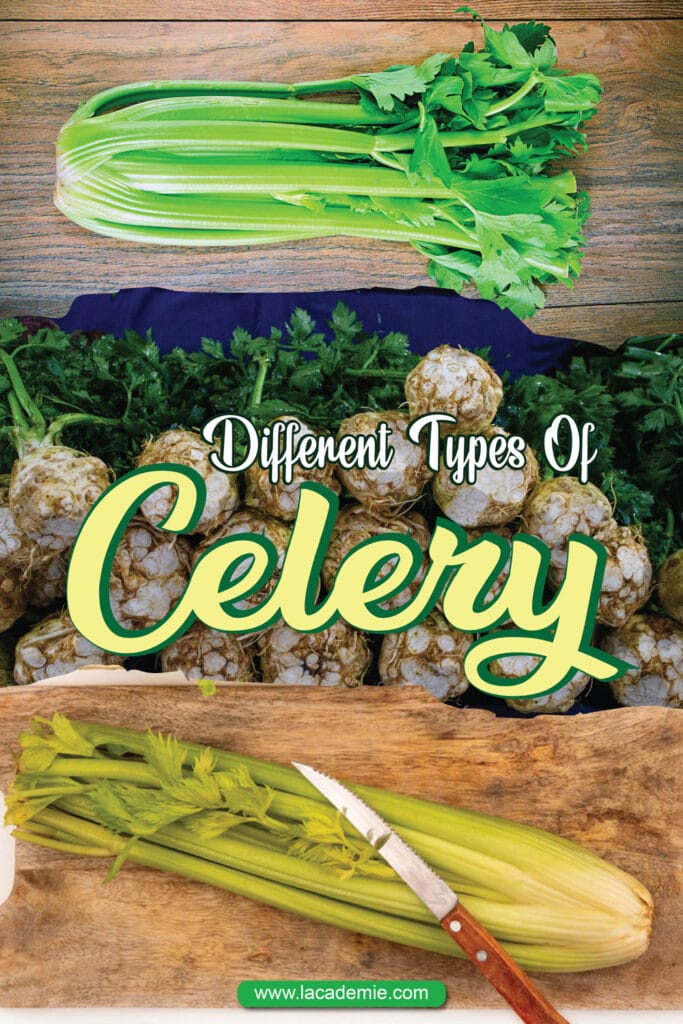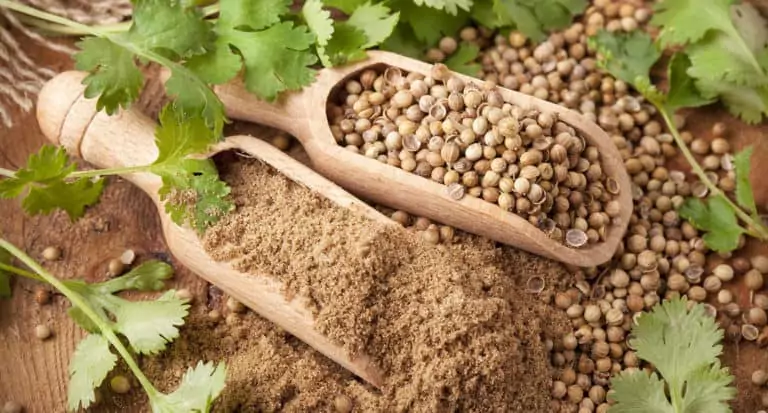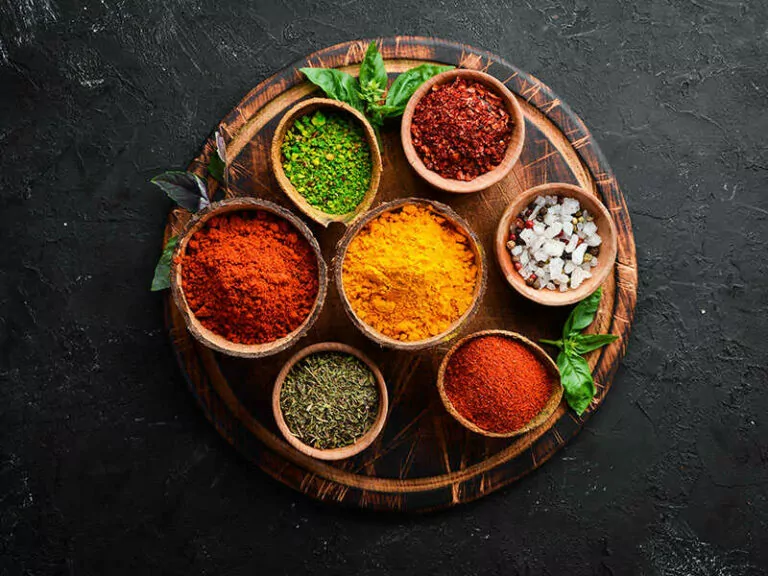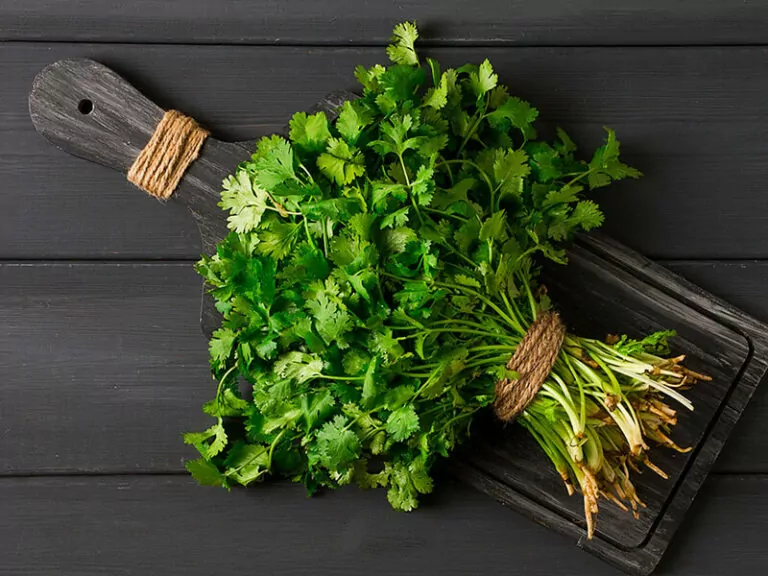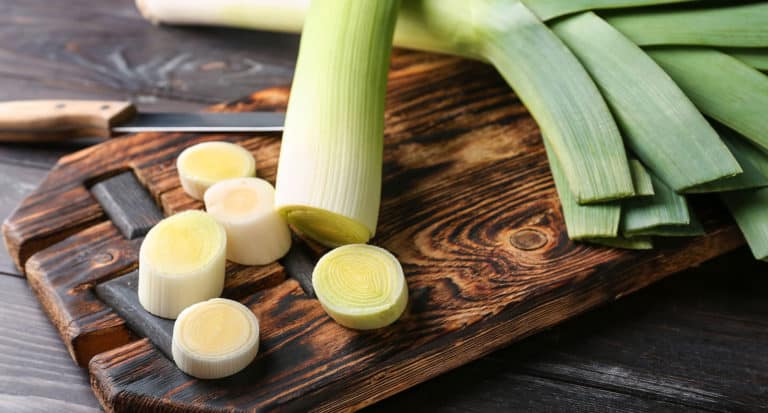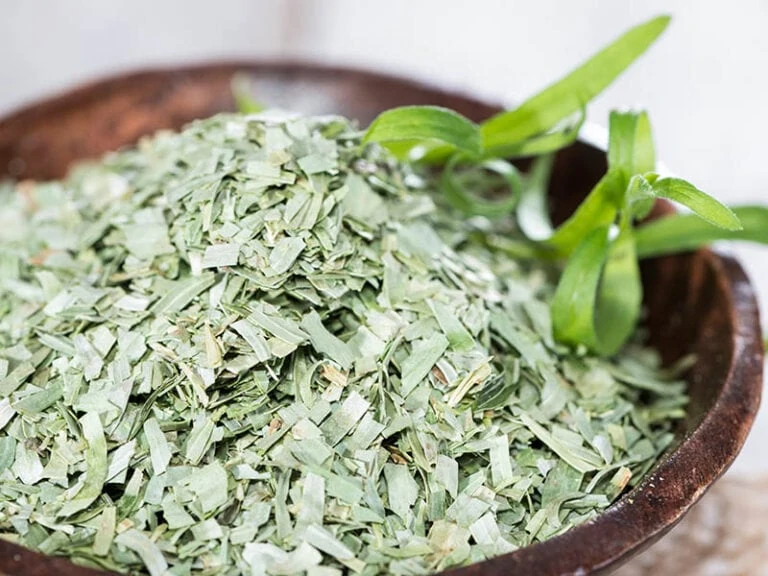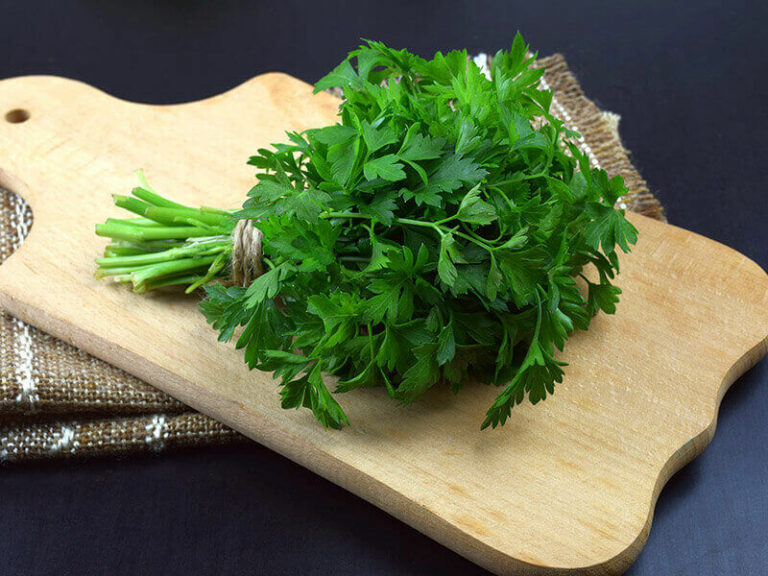There are many different types of celery, way more than you think. They vary in taste, appearance, origins, uses, and growing condition. But don’t feel overwhelmed by this huge amount of information because everything you need to know about these features is in this article.
If you are planning to cook with celery, you will find this article helpful. Gardeners who are thinking about growing this kind of veggie will learn a lot from it, too, because I have gathered all of the most amazing characteristics of various celery types for you.
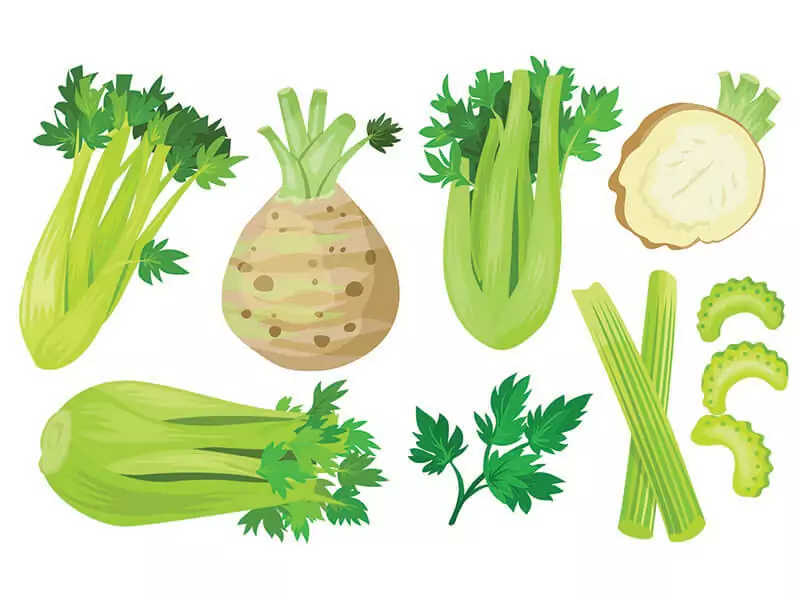
Celery – A Versatile And Delicious Plant
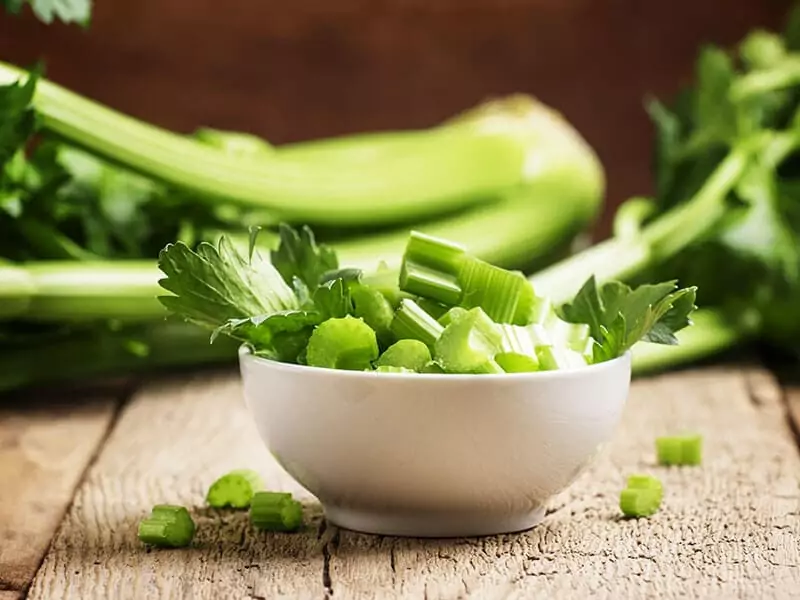
Have you ever made dishes with celery? If you haven’t tried it, you should do so right away because its subtly sweet flavor and delicious texture will bring you a great culinary experience.
Celery is loved for its versatility. You can use it in plenty of savory dishes, such as baked, fried, and braised dishes. It can also be a replacement for celery seeds.
But that’s not everything. Celery is also well-known for its great health benefits. It is packed with plenty of antioxidants, such as vitamin C, phytonutrients, and flavonoids. In addition, they contain a high amount of water and fiber, vital substances that keep your body working properly.
Celery also has a lot of minerals and vitamins, which can help you maintain good health. It can reduce inflammation and boost your digestive system. So is there any reason not to add them to your meal?
Classification Of Celery: An Overview
Celery is classified into 3 main types: celeriac, celery leaf, and Pascal celery. I will briefly go over the characteristics of each type so that you have good background information.
If you look for celery in the United States, you will mostly find Pascal celery. It is also called “stalk celery.” Another type is celeriac, which looks like a kind of root vegetable. People mostly eat its stems and shoots. This variety is mainly grown in Northern Europe and the Mediterranean Basin.
While celeriac has edible stems, leaf celery is an East Asian variety that is cultivated for the leaves. Many people call it “Chinese celery” or “Nan Ling celery.”
6 Best Types Of Pascal Celery That You Can Plant
Let’s first look at the most common variety, Pascal celery. Here are the 6 most popular subvarieties. The table below will show you their main features.
| Types of celery | Characteristics |
| Tall Utah | Large, crunchy |
| Conquistador | Crispy, slightly sweet |
| Golden Boy Celery | Mild, short |
| Golden Pascal Celery | Tender, juicy, cold-hardy |
| Monterey Celery | Anti-bolting, heat-resistant, disease-resistant |
| Giant Red Celery | Large, quick to mature, used to make soups and salads |
1. Tall Utah Celery
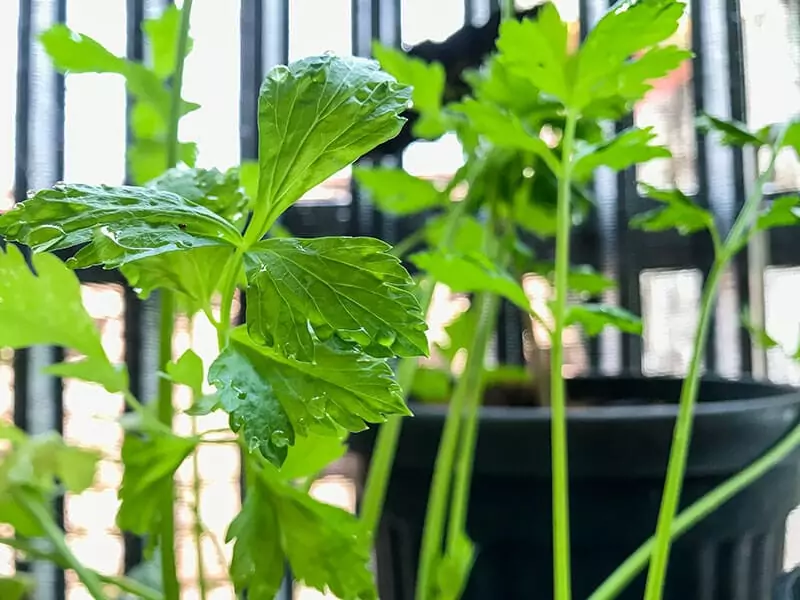
Let’s start with a popular one! That is Tall Utah. It has a very delicate taste, wonderful aroma, and crunchy texture that many people die for. More interestingly, it is the largest variety of celery.
Tall Utah celery has dark green stalks and stands against drought and diseases. This variety normally needs 100-125 days to grow, you should plant it in summer and prepare for the harvest in fall.
You may want to learn the method to pick Tall Utah.
2. Conquistador Celery
Conquistador has a crispiness and light sweetness that will please your taste buds. The most amazing thing about this variety is that it can endure drought better than the others.
In warm areas, Conquistador needs roughly 80 days to mature. It takes longer if the plants are grown in cold areas, stretching to about 115 days.
Conquistador is not a self-blanching variety, so if you want to enjoy the white stalk, you have to blanch it yourself. Or you can just enjoy the veggie as it is. Its crunchy texture and potent taste are incredibly delicious.
3. Golden Boy Celery
This golden-yellow variety has a wonderfully mild taste and milky white color. The stalks are quite short. You can harvest them in approximately 85 days when they grow to 18 to 23 inches in length.
4. Golden Pascal Celery
Golden Pascal celery is a French variety that can endure cold weather pretty well. You can harvest it 115 days after plantation when it reaches approximately 20 inches in length.
This variety has yellowish-green stalks. People also call it Giant Pascal or Winter King. This tender, juicy, and incredibly tasty type of celery has no string at all, so you don’t need to blanch it. Golden Pascal normally produces crops in autumn and winter.
Never miss the best technique to plant Golden Pascal celery.
5. Monterey Celery
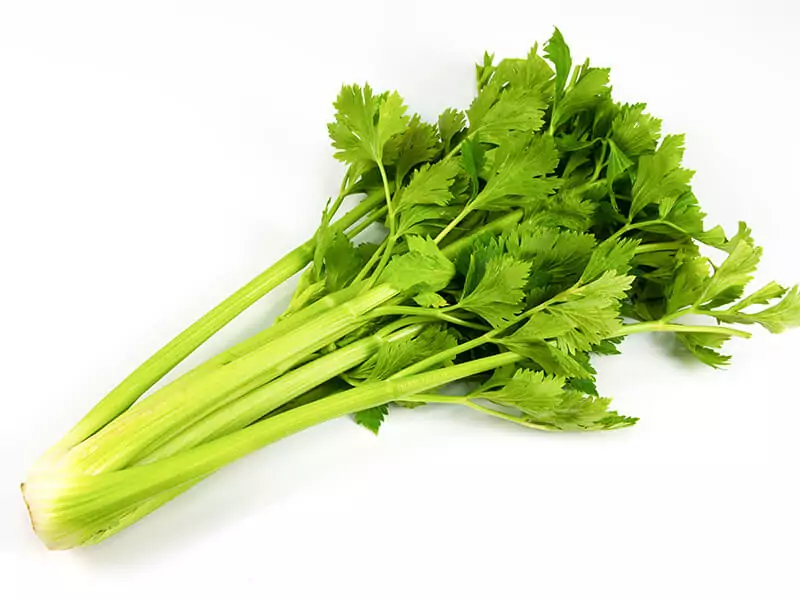
Similar to other Pascal celery, Monterey is a Spanish variety that grows very quickly, approximately 80 days. It is dark green in color and can be at most 12 inches tall.
You don’t have to worry about bolting when planting Monterey. It can stand against diseases and heat.
6. Giant Red Celery
Can you guess anything about this variety just by looking at its name? It must be a large one, right? Its plant can be up to 2 feet tall. Despite the large size, Giant Red grows fairly quickly. It will be ready to harvest in 85 days, even in the regions with low temperatures.
This large variety has an excellent taste. Its hearty nature makes it perfect for making soups and salads. You can turn it into a celery salad as a great side dish of chicken wings.
The outside has a reddish-purple color, while the inside features a beautiful yellowish-pink heart. When cooked, the reddish-purple stalk becomes pink. It has a hearty taste that is often considered stronger than other green varieties.
3 Types Of Leaf Celery To Open Your Mind
If you love the bright and refreshing color of celery, leaf celery is maybe your favorite variety. Let me guide you through the 3 most popular types so that you can choose the best one for your recipe. First, check out this table for some brief information.
| Types of celery | Characteristics |
| Par-Cel Celery | Crispy, adaptive to cold and warm weather |
| Safir Celery | Peppery, crispy, slender, used to make sauces, soups, and salads |
| Flora 55 Celery | Anti-bolting, flavorful |
7. Par-Cel Celery
Par-cel is a Dutch variety that originated in the 18th century. It has a delicious flavor and crispy texture. Its appearance is quite similar to parsley, especially the leaves, so you can use it as an alternative to parsley. Regarding the length, it can be up to 20 inches tall.
You can use Par-cel to garnish savory dishes, especially soups. More amazingly, it lives well in most growing conditions, such as dry, warm, and cold weather. You will get tasty Par-cel after 75 days of plantation.
8. Safir Celery
Safir or Peppery Safir is an outstanding celery variety which has a unique peppery taste and crispy texture. The stalks are very slender and can be roughly 12-14 inches in length. It takes 85-115 days for it to mature completely, depending on the temperature.
Thanks to its awesome hardiness, you don’t have to worry too much about pests and diseases if you want to plant Safir. With that distinctive taste, you can add it to your sauces, soups, and salad.
9. Flora 55 Celery
This dark green variety has an anti-bolting feature that a lot of growers love. It has an incredibly flavorful taste.
The plant can grow up to 12-inch in length. It will mature after 85-120 days of plantation, depending on the weather. I recommend that you plant it in early spring to get the best quality of the crops.
Growing leaf celery is much easier than you think.
6 Types Of Celeriac That Are Incredibly Delicious
For celeriac, the root is the most delicious part. If you are a fan of root vegetables, you should never miss it. Let me go through the 6 best subvarieties so that you will have plenty of choices. The table below will show you the essential information about them.
| Types of celery | Characteristics |
| Tellus Celery | Sweet, nutty |
| Marble Ball Celery | Medium, strong taste |
| Giant Prague Celery | Earthy, used in fried dishes and soups. |
| Brilliant | Large, flavorful, used for roasted dishes and soups |
| President Celery | Tender, mild, suitable for eating raw and cooking |
| Diamant Celery | Rich, nutty |
10. Tellus Celery
Unlike other types of celery, Tellus has a distinctive white color even when it is cooked. You will love this variety because it is effortless to care for and only takes a short amount of time to mature.
Tellus is also called “turnip-rooted celery.” It has a sweet and nutty taste which is perfect for making celery soups. You can also dice or grate it to add to your favorite winter salads.
11. Marble Ball Celery
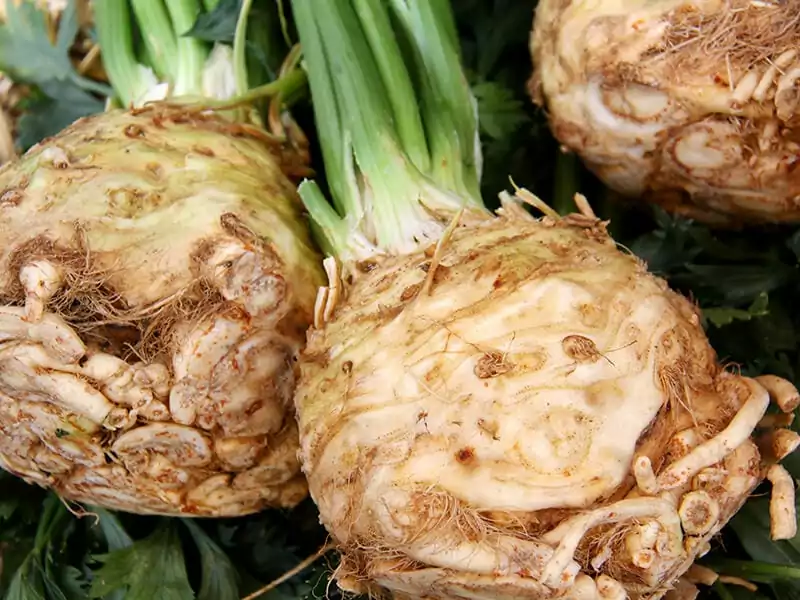
If you look for celery in the market, you will mostly find Marble Ball. It is the most common variety with a medium-size and overpowering taste. Its root is round in shape.
12. Giant Prague Celery
Originating in 1871 in Europe, Giant Prague celery is a large variety that can grow to 4 inches in diameter. The roots have a white color and an earthy taste that is similar to other varieties. After an 85-day crop, you will have a lot of Giant Prague celery to fry or make soups.
13. Brilliant Celery
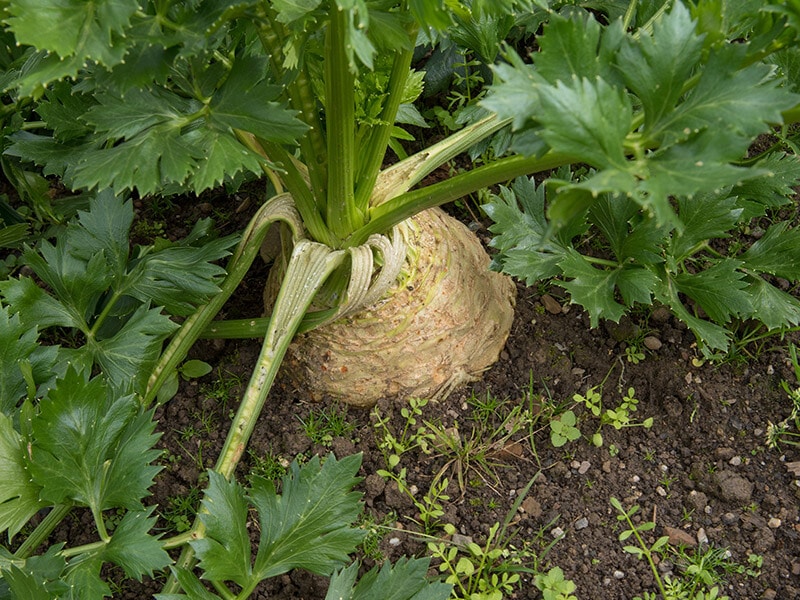
This variety came from England. The plants have the ability to fight against most diseases. The roots are very large, with an attractive round shape and dense texture. They are usually harvested 110 days after plantation.
With a flavorful taste, Brilliant variety is suitable to make roasted dishes and soups. You can also cook it with other root vegetables.
14. President Celery
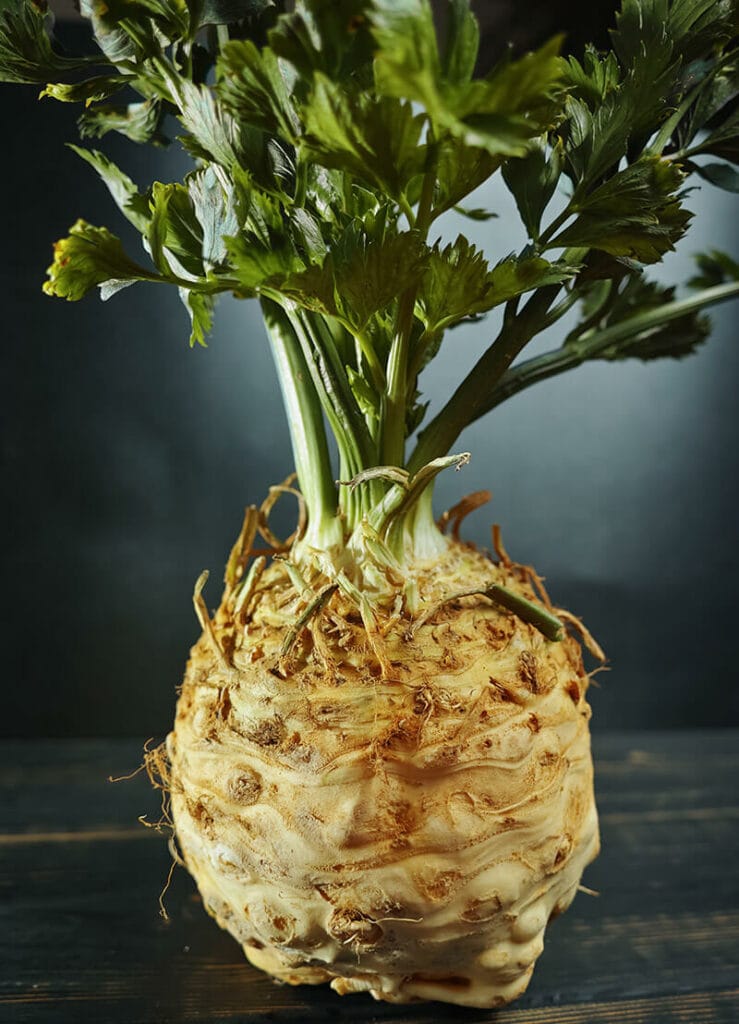
If you are looking for a celeriac variety that is both perfect for eating raw and cooking, President is a great choice. You can harvest tender and mild-tasting roots in 110 days. The later you harvest them, the largerthe roots will be.
Given the delicious flavor of President celery, it makes a great side for fish-based dishes and beer. You can also add it to plenty of dishes such as side dishes, meat dishes, soups, salads, and sauce.
Celeriac is perfect for making soups, especially celeriac and walnut soup.
15. Diamant Celery
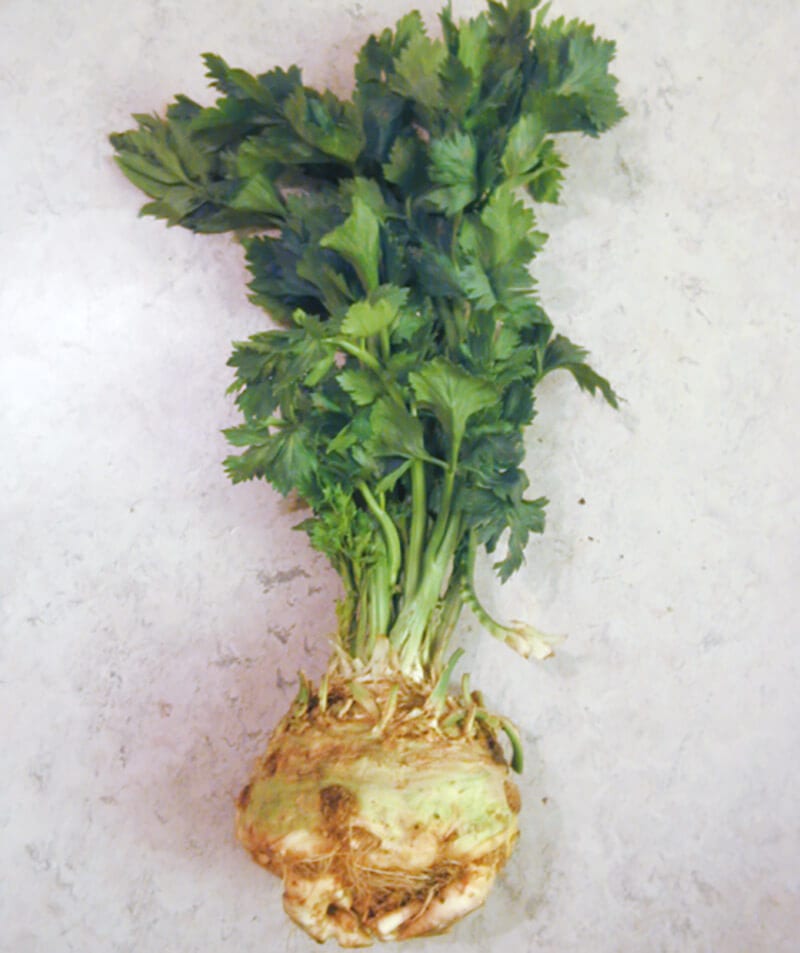
Diamant is the most popular variety of celeriac. This heirloom variety from the Netherlands has the typical rich and nutty taste of root vegetables. Its flesh has a chalky color that looks fresh and lively. After planting, you can harvest the roots in roughly 3 months.
How To Store Celery Properly
Knowing how to store celery is important, and I am glad to share useful tips with you. Let’s go straight into it! I will also provide you with information about the shelf life of celery.
When storing celery, a rule of thumb is to keep it in its whole form. Don’t cut it! The best place to store it is in the crisper drawer.
You also need to wrap the celery in aluminum foil. Wrap it tight enough so that the moisture won’t get out. But make sure that the stalks are not damaged. With this method, you can keep it fresh for up to 1 week.
If you have already cut the celery, don’t worry, you can still keep it fresh as long as you follow this method. Fill a container with water and put the cut celery in it. Then place the container in the fridge. This way, the celery can stay fresh and crispy.
Are you wondering about the best method to freeze celery?. Follow these 6 basic steps: washing, trimming, chopping, drying, flash freezing, and freezing.
4 Celery Recipes That You Can’t Refuse
I have mentioned a lot about how celery is used in a general way. In this section, I will write in detail about what you can do with celery and give you some excellent recipes to try. Let’s move on!
1. Celery Soup
If you are finding a cozy dish for dinner, don’t miss this celery soup recipe! With a slightly sweet taste and creamy texture, it will definitely win your heart. Such a healthy, delicious, and affordable dish should never be missing from the list of your favorite recipes.
2. Stir-Fry Celery
Stir-fried dishes are a perfect choice for lunchtime. They are delicate and very easy to make. This time, let’s stir fry some celery. Pascal celery or leaf celery is most suitable for this recipe since only the crispy stalks are used.
3. Braised Celery
Braised celery is a great side dish for any party. It requires the heart of the celery, which is the part that people often remove when making other dishes. Using the leftover part of the celery to make a delicate dish, is there anything better than that?
4. Celery Salad
Celery is refreshing and nutritious. Its high water content makes it a perfect ingredient for salads enjoyed in winter. Feel free to mix it with any other component you like. Add cheese or mayonnaise for some richness. You can spice up the dish with mustard, raisins, and nuts.
This celery salad recipe will make your mouth water.
You Will Love These Types Of Celery Even More After Trying Them
Celery is an amazing plant. It is diverse in taste, appearance, and uses. Some varieties make use of the leaves, while for others, only the roots are edible. After reading this article, you can choose the most suitable type of celery, depending on your purposes.
If you know any other interesting information about these types of celery that is not in this article, feel free to leave them in the comment section for other readers. And, don’t forget to share this useful article with your friends and relatives.
